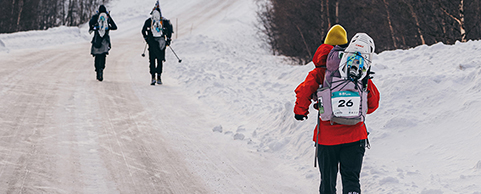Climbing Mt Kenya: Hard Decisions on The Ice Window

Ice climbing in Africa, on the continent’s second-highest mountain
It’s late September. Dave Wallis and I are in Kenya to climb the Ice Window and Diamond Couloir – two incredibly striking lines up the south face of the highest peaks on Mt Kenya. A massif crowned with a cluster of pointy spires, at 5199 metres, Mt Kenya is the second-highest mountain in Africa.
Sitting only a few kilometres south of the equator, you can walk around Mt Kenya, and thus walk from summer to winter to summer again in one day.
It’s spring when we arrive to climb ice on the south face. Every day, the weather comes in around lunchtime. Before the clouds roll up the Teleki Valley, we manage to sneak a look at the bulk of Mt Kenya, and the dollop of white that is the Tyndall Glacier.
The routes look stunning. The Diamond is a beautiful strip of ice bisecting the south face. It continues directly up from the Diamond Glacier at the bottom to the Darwin Glacier, right below the Gate of Mists – a dramatic cleft between Mt Kenya’s twin summits, Nelion and Batian. The Ice Window is largely hidden from view, hiding behind a corner. It starts a few hundred metres to the right of the Diamond and tends leftwards to join it a pitch or so below the Darwin Glacier.
Most of the route beta we have is at least a decade old. Even these reports warn of a shortening season, and the effect of climate change on these ice climbs that sit a quarter of a degree south. Everyone we speak to tells us, “No one climbs those routes anymore.” But, as Australians growing up on Mt Buller trips, we are used to thin ice.
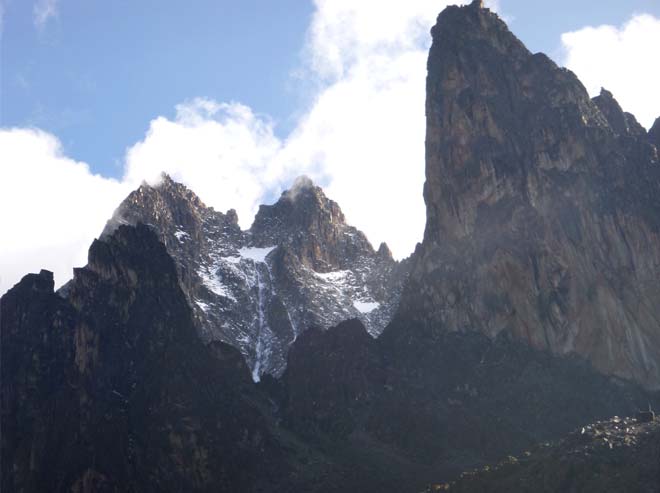
Getting acclimatised on Mt Kenya
Before we take on the climbs, we do some acclimatising. We walk up Mt Kenya and back down via the Naro Moru route – the shortest, but steepest, and most popular walking route.
The trail begins through forest before entering alpine moorland not dissimilar to the Victorian High Country: low alpine grass and the occasional skeletal tree. We stop at Picnic Rocks to snap some pictures and have a bite to eat.
We leave our morning tea spot, and it isn’t long after when the clouds grow thick and rain begins to fall. At first, not much. But, it isn’t long before we’re pulling out rain coats and contemplating overpants. As we collect water from Teleki Creek, the rain turns to sleety hail and the wind picks up.
We’re relieved to make it to MacKinders Hut for a late lunch, while the weather thrashes the mountains. The hut is at 4200 metres. We’ve climbed over 1000 metres that day. We certainly don’t have altitude sickness, but the thinness to the air is noticeable.
Our porters arrive a few hours later, having sat out the worst of the weather. Dave and I cook up rather uninspiring freeze-dried meals. Smells of chicken and onion waft from the porters’ end of the hut, and we begin regretting our decision to look after our own food. We spend the evening watching the weather try to clear. We get a few glimpses of the peak, which is much closer now. We can pick out the Diamond Couloir, the dominant ice line on the south face.
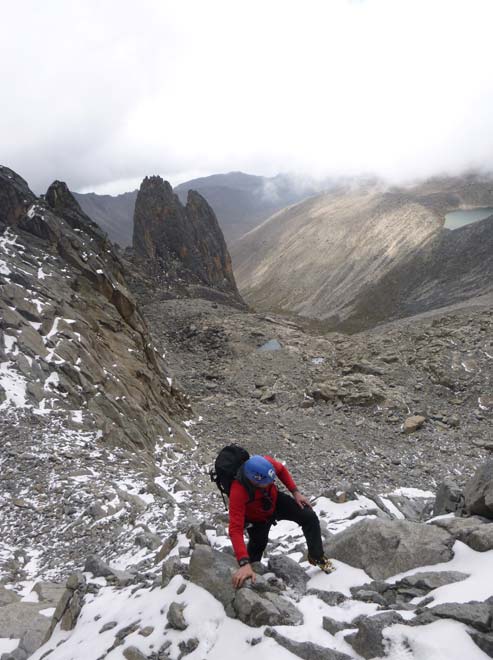
Approaching the Ice Window and Diamond Couloir on Mt Kenya
In the morning, it’s clear and sunny again. We divvy up our gear: ditching sharps, mountain boots and most of the rack for a two-day jaunt up to Austria Hut. At 4800 metres, it’s a good base to acclimatise some, do some cragging on Point John, and wander up Lenana (the third-highest peak on Mt Kenya and the highest one can get to without actually rock climbing).
We take two porters carrying smaller packs. The landscape is dominated by Lobelias that remind me of Dr Seuss’ The Lorax. We trudge up scree and moraine. Through a col on the Point John ridge, we get more glimpses of the Diamond and Ice Window routes. We excite ourselves by deciding that they are well and truly in condition.
Austria Hut is much smaller than Mackinders. It’s in a rather desolate spot, too – in a field of rocks created from the Lewis Glacier’s moraine. Our porters dump our packs and head back to the more luxurious Mackinders. We’d meet them again at the base of the south face in two days’ time.
It’s early, and so sunny. We wile away an hour or so, settling in. By the time we have a bite to eat and decide to head up Lenana, the clouds roll in again, and it’s snowing – this time, pretty hard. Undeterred, we layer up, and head out. Lenana is directly above the hut, along the moraine ridge, and it’s an easy scramble to the top. I can’t say what the views are like, because we can barely see a few metres in front of us. Back to the hut for a cup of tea.
Overnight, everything is plastered in an inch of snow. Cragging on Point John is now out of the question. So we explore the Lewis Glacier, and climb a few snow-covered pitches of easy rock to get in the groove. But, mostly, it’s a boring day of killing time and watching the clouds build and swirl about the tops, and snow some, then dissipate, then build again.
The following morning, we’re up early. By 8.30am we’ve descended to the American Camp in Teleki Valley. By a small stream, we collect water amongst the Lobelias. Here, we meet up with our porters, who are carrying ice gear up from Mackinders. From this point, it’s a long slog up largely pathless talus; a slow scramble that takes two hours for a few hundred metres of ascent. In the middle of the talus field below Mt Kenya’s south face is the ominously named Black Hole Bivvy – a large boulder propped above the talus with room for two (maybe four at a pinch) under a low roof, and rock walls built up in the gaps. It isn’t much, but it’s perfect for us to get a good night’s sleep before having a crack at the routes. The porters wish us luck, and head back down to the comfort of Mackinders.
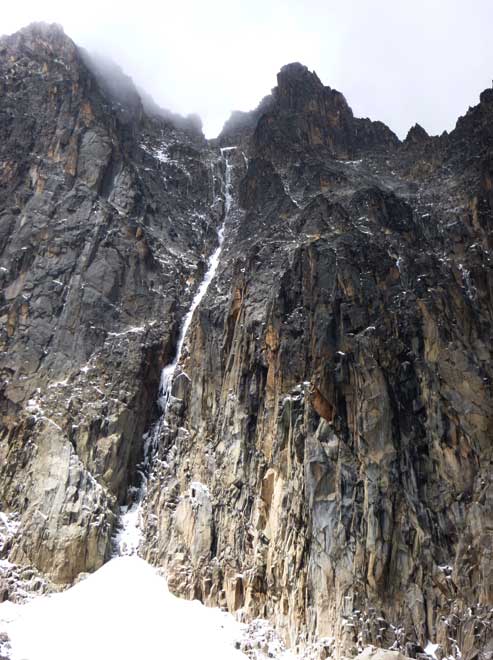
The Ice Window recce, Mt Kenya
From Black Hole Bivvy, we have a good view of the Diamond. The top two thirds look great, but the bottom is almost non-existent – a series of shitty, thin icicles linking up in the gully, barely dripping down to what is left of the lower glacier, now little more than a snow debris cone.
We’ve come to climb The Ice Window, but figured if the Diamond is in condition, we’d have a crack at it, too (and have given ourselves enough time to do both, if we want to). But with the Diamond decidedly out, it’s looking to be just The Ice Window. It’s disappointing, and worrying, since we can’t see The Ice Window. We feel that the lack of ice on the Diamond could reflect conditions in The Ice Window.
But, we don’t let our disappointment show. Once the porters leave and we finish our cups of Milo, we head up to The Ice Window for a recce, and to fix ropes if needed.
It’s a slog up the talus. We make it to a snow patch/avalanche path/remnants of a glacier – essentially the base of the route – in half an hour. It’s hard to interpret the guidebook, since the routes are so affected by climate change. Phrases like “at the top of the glacier” or “where the ice steepens” means little in what is now, 10 years later, a talus slope. So we follow the path of least resistance up the talus, and onto some rock steps, with some streaks of ice smeared on them, until it all gets too much, and we rope up.
Pitch one: M3+, 40m. Rock, with a little snow and some ice at the very top. It’s tempting to follow a weakness left, but this leads to featureless rock. It goes by traversing right, around an exposed corner, then up over some awkward chockstones to an icy patch of snow as the terrain levels out. The gear is some cams, wires and a piton. I set an anchor with a wire and piton, and belay Dave up.
From here, we have a good look at the route for pitch two: it’s a 60-degree snow slope, before the gully turns left and goes out of sight. There doesn’t seem much point in recceing any further, so we fix a rope to make the ascent tomorrow easier. We rap, fixing another rope down to the snow patch to save time the next morning (it’s an awkward downclimb). We also cache the rack and sharps.
We descend back to the bivvy, where we spend the afternoon relaxing. It snows again, as it has done every other afternoon. We fret about our ropes freezing, while water drips down the rock roof onto our sleeping bags.
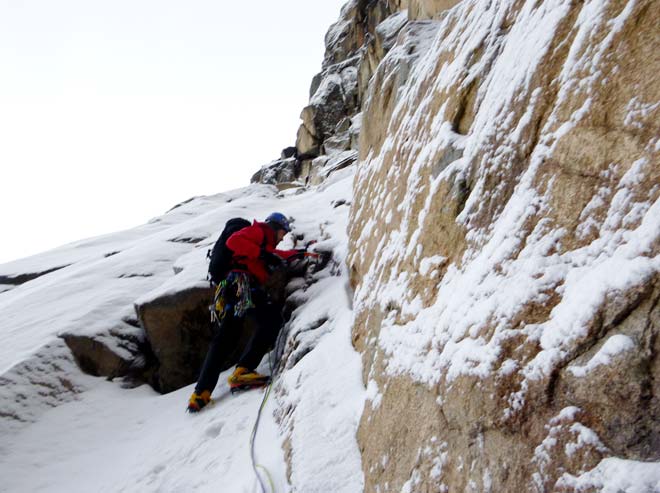
Climbing The Ice Window, Mt Kenya
At 4am, my alarm goes off. We hope for an early start. Alas, our gas can is nearly empty and it takes a long time to get a brew going. It’s over an hour before we’re ascending the talus by headlamp. The sky is slowly turning a beautiful purple.
As it grows light, we reach the first rope and our cached gear. Moving slowly up the two fixed ropes, the altitude is making moving fast a real effort. We are both pretty spent when we re-rack for Dave’s lead up the snow slope.
Pitch two: AI2, 90m. Fifty- to seventy-degree snow slope with a few sections of ice. We stretch this pitch out with some simul-climbing. The soft snow and altitude slow us down on this not particularly technical pitch. It takes one or two wires and a few screws in shitty ice, but the belay Dave builds is in a crack that looks like it’s only held together by ice. From here, we can see farther up the gully. Ahead, there is an ice-snow-rock mixed pitch that looks like it would be great fun. It’s starting to feel like we’re really on the route now.
I’m shagged by the time I reach Dave. He’s cold, so he takes the next lead.
Pitch three: M3+, AI2, 60m. Straight up the guts of the gully, following the snow mostly, but with some increasingly technical rock steps, finishing with a sloping, steep ramp with little protection. A great pitch with a little of everything, including Dave fiddling about with the rack high above his last piece, in an awkward stance, calling out, “Shit! Shit! Shit!” and dropping all the wires onto a patch of snow halfway between us.
Interestingly, there is evidence of previous parties: tat on horns here and there, but mostly a metre (or two, or three) above where we were climbing, which makes us wonder about the depth the ice has been in the past, and how shallow it is now. The gear is all rock: wires, cams and some slung horns. Dave’s anchor is an enormous boulder, already with four or five slings around it, which he too slings.
From here, we can see farther, again. The route looks incredible: a thin sliver of ice, deep in a gully; an incredible, atmospheric pitch with great architecture to the rock. I dick around for a while, trying to work out the best way into this gully, as it was below us. I try going up, then across. But, this is no good. After 20 minutes of faffing, Dave lowers me in, and I start climbing the gully. It’s mid-morning: not late by regular alpine climbing standards, but the afternoon weather is already building, down below us.
Pitch four: AI2, 50m. Straight up the gully, on sometimes snow, sometimes ice, all of it very thin and shallow. But, a beautiful section to climb. Once I’m in the gully, I fly up, placing a few wires and a piton. At the top, the gully loses its steepness for a section.
Here, I sling a horn to belay Dave up. I have an incredible view of the route above me: a beautiful ribbon of ice stretching up, with the upper Diamond immediately to my left. I can almost make out the spot where The Ice Window joins the Diamond – a pitch or so before the final glacier below the Gate of Mists. It feels great to be here. Dave calls out.
“What’s it look like?”
I tell him it’s awesome. He comes up fast behind me, and takes a look at the route above us.
“Jesus, it’s thin.”
I look again. He’s right. Too excited about the aesthetic of the route, and the incredible architecture of the rock, I’ve failed to notice that the ice looks a little rotten.
We glance at each other. Dave has coveted this route since the ’90s, and I have for the past two years (since he’d been in my ear about it). It’s been a feature of our lives for a while now, and I’m unable to grasp the idea of not climbing it. Dave, I can see, is heart-broken.
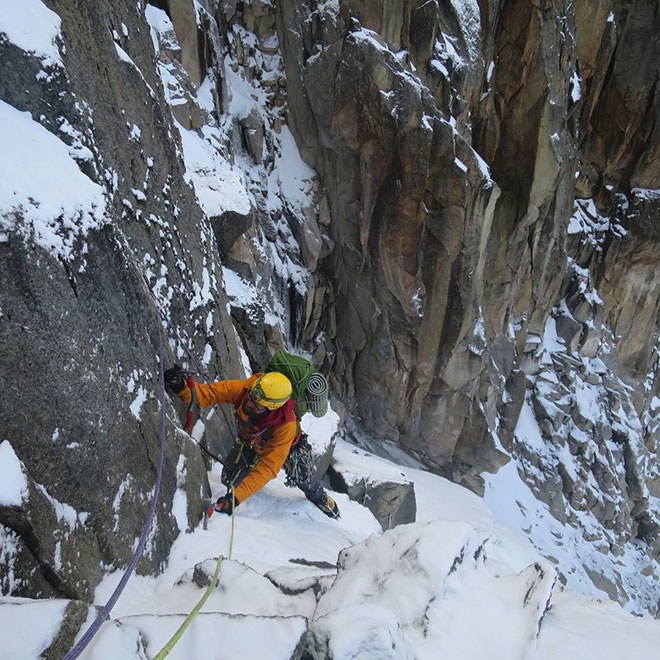
We throw ideas around: Maybe the weather won’t be too bad this afternoon? Can we climb faster? How much will the thinness slow us down? Is it really that thin? Do we really need to stop to melt snow for water? Could we bivvy behind an icicle for the night? Or for the afternoon while it snows? How many pitches do you reckon we have to go? How hard is that final pitch of rock up to the Gate of Mists really going to be? Will we make it there before the weather? Before dark?
Hard decisions climbing Mt Kenya
It boils down to this: The route was really thin. We probably have at least five pitches to go. We’ve been climbing about a pitch an hour (slowed by conditions, atmosphere and interpreting the guide and route topos poorly). And we’d most likely be climbing slower on the thin stuff above us. We desperately need to stop to melt snow – and this would kill half an hour. We’re both struggling with the altitude. The route is likely to be two or three pitches of thin ice, until it joins the upper Diamond. After this, a short pitch on the upper Diamond, which would be steep and/or thin. Then up the less steep glacier to the final, and crux, pitch of likely bare rock, to the Gate of Mists, which we would probably be doing in the worst of the weather, and possibly after dark. And finally a pitch or two of scrambling the final summit ridge to Nelions summit, and the Howell Hut, perched on the summit.
The hardest part about the decision is that it’s clear that the route can go. It’s all climbable, but we’re climbing too slow. And the weather is a big factor. We don’t want to deal with the final pitch to the col in the afternoon snow storm, and certainly not after dark.
“Picture the route without the last week’s fresh snow on it,” Dave says.
It does all look very alpine with an inch or so of snow, but this is deceptive. Had there been no snow on the rock, it would look so much more obviously un-climbable – a skidmark of poor snow and ice in the gully.
So, with dread, and heavy hearts, and almost entirely in silence, we rap the route. It’s almost like we we’re itching to get off the mountain now – leaving tat and a few pieces behind to speed things up. Comfortingly, it’s pouring snow and sleet when we arrive back at the bivvy. We have a quick brew. Knowing that this has been our sole chance on the route, we retreat back down to Mackinders Hut.
We pull in late afternoon, spent. After a quick dinner, we’re in bed not long after 5pm. We sleep a full 12 hours. Again, this is comforting: the final kilometre to the hut is hard work, and we’re both exhausted. We think of how we’d be coping if we were still high on the mountain, dealing with the weather and the crux pitch all at once.
A few days later, Dave flies home to Melbourne and I to Zanzibar to begin a four-week trip that sees me circle Lake Victoria through Tanzania, Burundi, Rwanda, Uganda and back to Kenya. I spend many nights drinking Tusker beers in various bars across east Africa, second-guessing our decision. I hope we get a chance to have another crack. I think about what we’d do differently: better food, more acclimatising, try earlier in the season.
Back in Melbourne, I meet up with Dave. He’s been second guessing our decision too. He tells me he’s received emails from Mt Kenya’s Parks Warden, asking if we are interested in returning to train Parks staff in 2017. He writes that he’ll let us know when the ice looks best. And if we can drop everything, we would be able to both climb the route and help out the staff. So, it’s looking like we’ll get a chance to finish what we’ve started.
Gear for Climbing Mt Kenya
Sleeping bags:
Dave and I both used sleeping bags rated to about -10 degrees Celsius. The nights can be outrageously cold on Mt Kenya (and Kilimanjaro), and many outfitters recommend -20 bags. It’s hard to wrap your head how cold it can get, when during the day it can be a pleasant 10 degrees in the sun. But, the nights are very cold. My Mont Highland kept me warm and, with Hydronaute XT, dry in the bivvy. We didn’t have bivvy bags or tents. A tent would be necessary for some of the other hut-less routes up the mountain, and may have allowed us to get a better night’s sleep in the bivvy.
Ice tools:
The routes were meant to be ice routes. We expected them to be more mixed (rock and ice), since climate change has affected the mountain. Both of us used crampons with vertical front points. Dave’s were mono-points, which were probably better. Similarly our axes were of the technical variety; my Grivel Air Tech Matrix excelled.
Packs:
Climbing packs of 30-40 litres were required for the technical climbing. We carried our day-to-day stuff in them during the walk-in.
Water treatment:
We treated all our water with the Camelbak All Clear, which was an excellent product. Dave had not used a UV water treatment before and considered it some kind of black magic.
Gas stoves:
We were unsure about whether gas would be available in Nairobi. We ended up purchasing a shitty stove and canisters there. However, the screw-type canisters for MSR and other modern gas stoves are available from larger department stores in Nairobi, and kerosene and unleaded petrol from any petrol station. If I had my time again, I would take my Soto Muka stove or any other reliable liquid fuel stove.
Food:
We brought some freeze-dried meals over from Australia. Most food for the trip we bought from a large supermarket in Nairobi. Supermarkets there are well stocked. But, we found the powdered milk to be sub-par, and packet soups were hard to come by. If I had my time again, I would have the porters cater whenever we were together, because their meals always smelt delicious. (We saw some porters pull an entire chicken from their pack in Austrian Hut!) Generally this is included as a service when porters are hired.
Mark Clavarino works at Bogong Equipment.
See more of Mark’s adventures here.
Read more Bogong Blog.
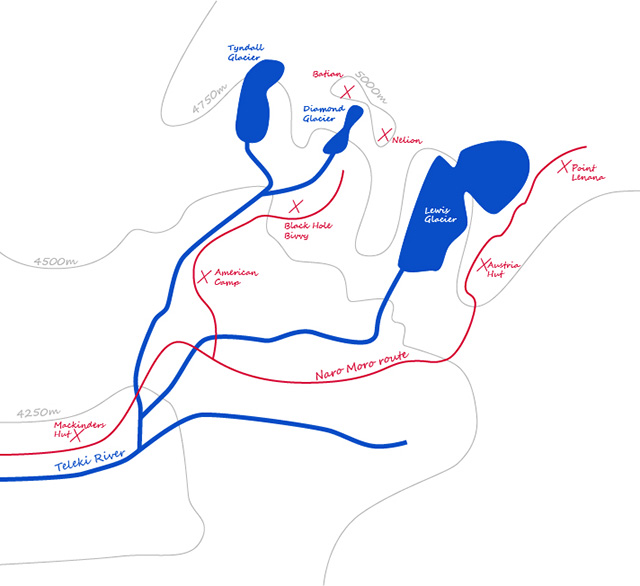
Bogong Equipment sells mountaineering equipment. We use it, we sell it!

















